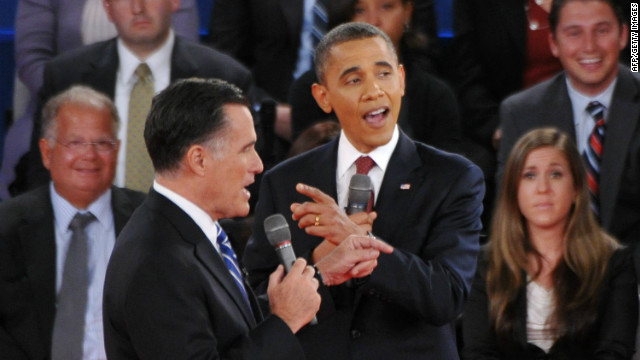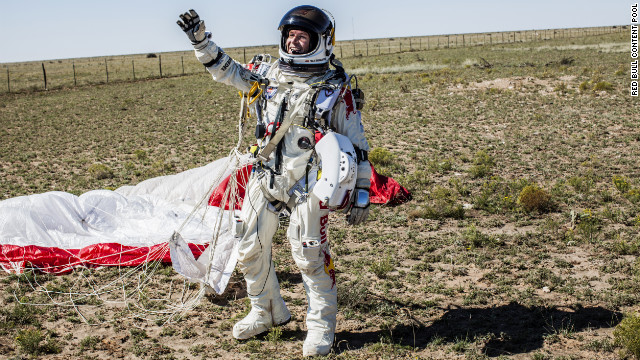October 14. 2012 -
ROSWELL, N.M. — Austrian sky adventurer Felix Baumgartner made history Sunday when he successfully leaped from a helium balloon 24 miles in the sky, hitting 729 miles an hour in descent.
Baumgartner accomplished the feat 65 years to the day -- Oct. 14, 1947 -- after pilot Chuck Yaeger broke the sound barrier in an aircraft.
In an echo of the late Neil Armstrong's words as he set foot on the moon, Baumgartner paused on the small platform before diving and said, "Sometimes to you to go really high to see how small you are." He then jumped from 128,000 feet
above the earth.
The mission, dubbed Red Bull Stratos after the Austrian energy drink that sponsored the jump, was five years in the making, and set records for the highest freefall and highest manned balloon flight.
While the aim of the mission was partly to break records, it is significant in that it marks yet another advance in aerospace adventuring on the part of private companies -- which also include Elon Musk's SpaceX and Richard Branson's Virgin Galactic -- as traditional government-sponsored events begin to wane.
Baumgartner's jump was not without drama. He complained of a lack of heat in his helmet visor on the way up, which caused mission engineers to debate whether or not to bring him down in the capsule. Then, on the descent, the skydiver could be seen spinning wildly, something that could have led to a loss in consciousness.
Baumgartner got the spin under control and minutes later glided to earth. When he landed, he sunk to his knees.
The effort began earlier Sunday when a 30 million-cubic-foot helium balloon hoisted a 3000-pound capsule carrying Baumgartner toward an adventure that was postponed Monday and Tuesday -- and for a few hours today -- due to high winds.
As Baumgartner heads up, the only voice in his ear is that of retired Air Force Col. Joe Kittinger, 84, his mentor on this Red Bull Stratos project and the holder of the record the Austrian is trying to beat.
Baumgartner has been working his way up to this world record jump from the edge of space for the past few years, twice running into speed bumps.
Austrian promoter Daniel Hogan derailed the first mission when he sued Red Bull Stratos -- the Austrian energy drink that is sponsoring Baumgartner's attempt – claiming he'd thought of the idea first. That suit was settled out of court last summer.
The other hiccup was more serious. Unaccustomed to freefalling while confined by a helmet and cumbersome suit, Baumgartner started suffering panic attacks and pulled himself off the project. He overcame his fears with the help of a sports psychologist.
"It was simple stuff," Baumgartner told USA TODAY in August after making his final test jump -- from nearly 100,000 feet -- outside the desert town of Roswell, N.M. "I'd put on a helmet and tell him, from one to 10, how panicked I felt. And in the end, no matter what the number was, he told me my pulse rate never changed. So it was all in my head."
For a quick primer on Baumgartner, head to YouTube. The Austrian daredevil broke through the extreme sports world clutter in 1999, when jumped off the world's tallest building (Kuala Lumpur's Petronas Towers, 1,483 feet) and jumped off Rio de Janeiro's 130-foot Christ the Redeemer statue (the video shows him scurrying directly into a waiting getaway car before police can arrest him).
Austrian energy drink maker Red Bull, known for sponsoring extreme athletes, promptly signed up Baumgartner, who finally realized he could make a living off doing dangerous things. In 2007, he and Red Bull decided to make an assault on Kittinger's 52-year-old record.
Kittinger, who had made his pre-Mercury program jump from 102,800 feet out of an open gondola and with rudimentary equipment, had long resisted efforts to recruit him to help others break his record. But ego wasn't the issue, he said, it was a lack of capital and seriousness that always caused him to say no.
"This whole deal is very expensive," Kittinger told USA TODAY. "If what I rode into space was a Model T, this is a Ferrari."
A visit this summer to Baumgartner's Red Bull Stratos compound on an airfield outside of Roswell revealed a simple if technologically sophisticated operation consisting of a few trailers and glass and steel structures crammed with computers and other gear to track the sky adventurer's ascent into the darkness of space and return to earth within miles of the lift-off spot.
The risks of Baumgartner's jump all link to the fact that in leaping from 120,000 feet he will likely go supersonic (around 700 miles per hour, depending on a range of atmospheric factors), which Kittinger did not from his lower altitude. The key for Baumgartner will be to keep himself from going into an irreversible flat spin in the initial stages of the jump, which could lead to him losing consciousness and irreparably damaging internal organs.
Baumgartner started his ascent to the stratosphere from this desert town better known as the site of a rumored UFO landing in 1947.
Jumping from more than three times the height of the average cruising altitude for jetliners, Baumgartner expected to hit a speed of 690 mph or more before he activated his parachute at 9,500 feet above sea level, or about 5,000 feet above the ground in southeastern New Mexico. The total jump took less than 10 minutes.
The energy drink maker Red Bull, which is sponsoring the feat, promoted a live Internet stream of the event from nearly 30 cameras on the capsule, the ground and a helicopter. There was a 20-second delay in their broadcast of footage in case of a tragic accident.
Baumgartner said before the jump that making history wouldn't encourage him to try anything like it again.
"This is the end of my journey," he says. "I've always been trying to find my limit, and this pretty much it. For the second half of my life, I want to be a good helicopter pilot. Fight fires. Rescue people. That would be fun."


















